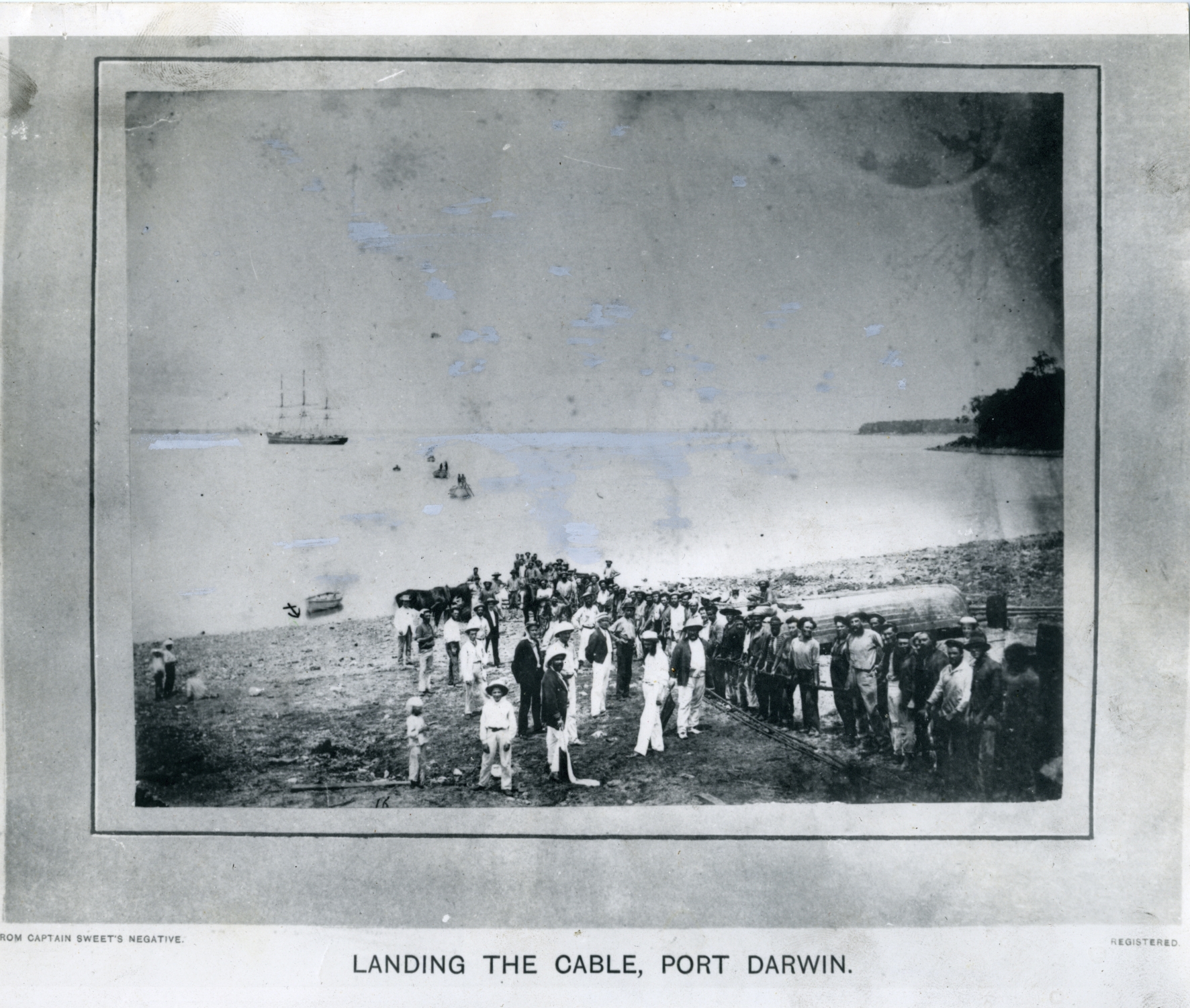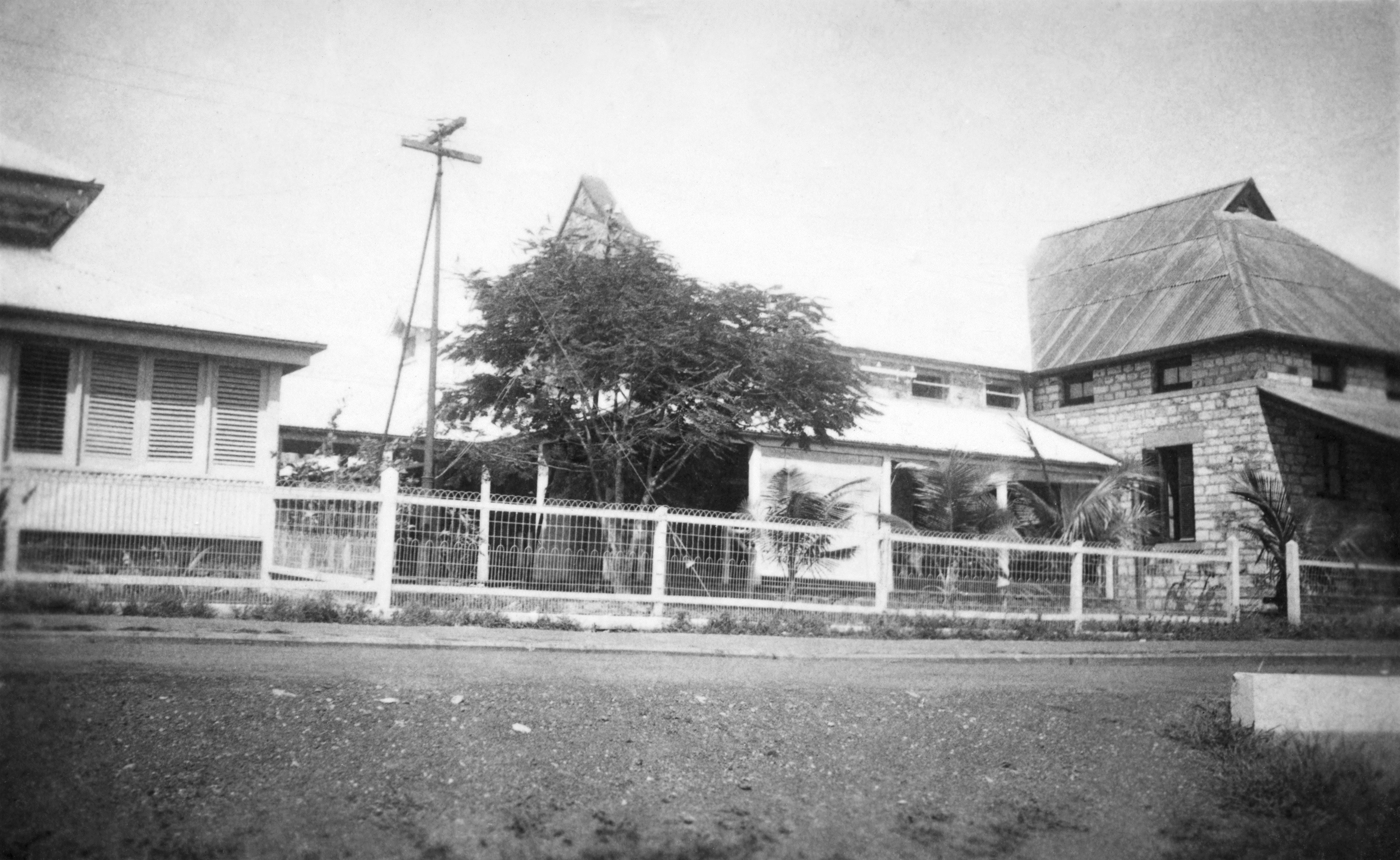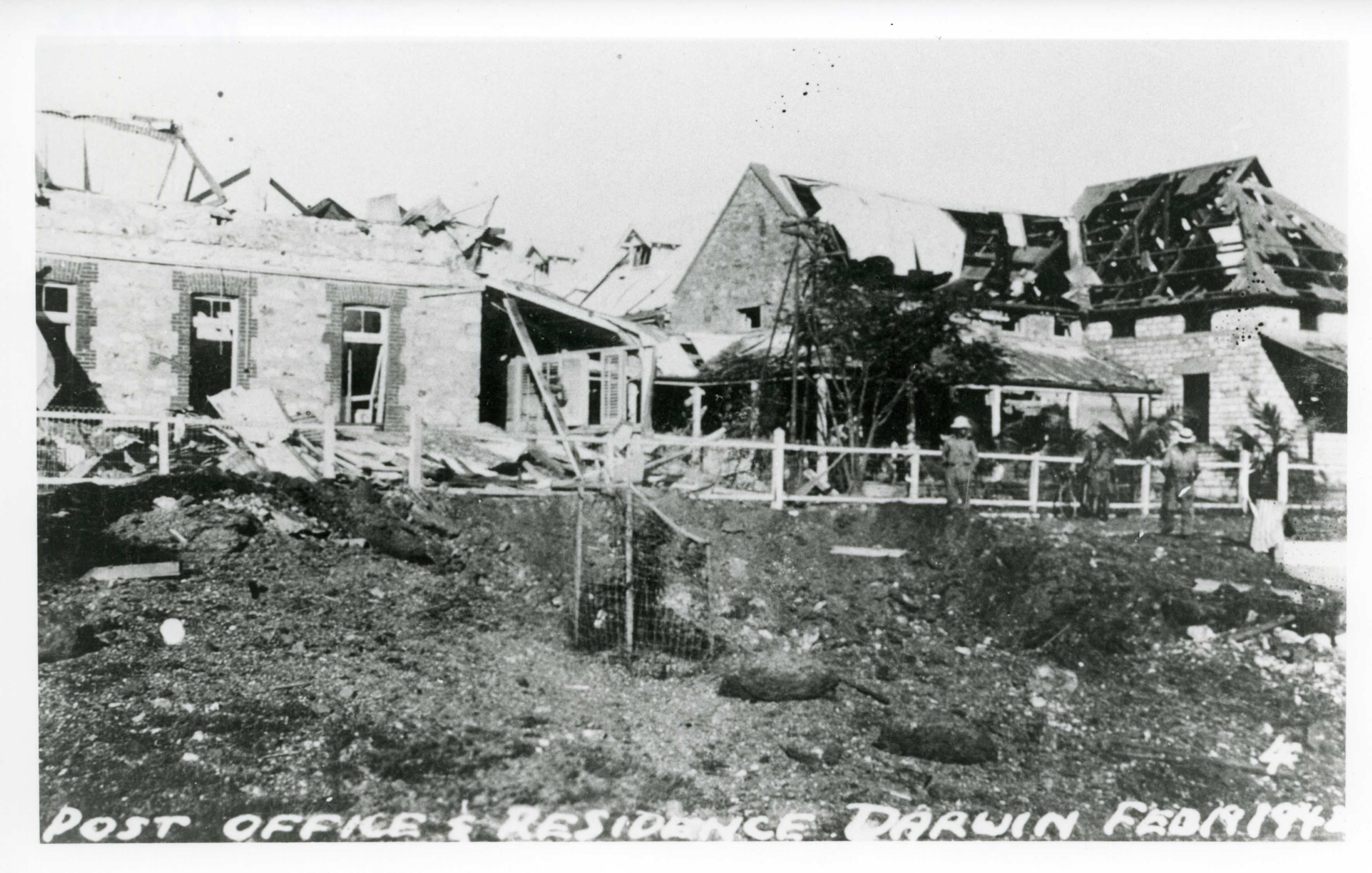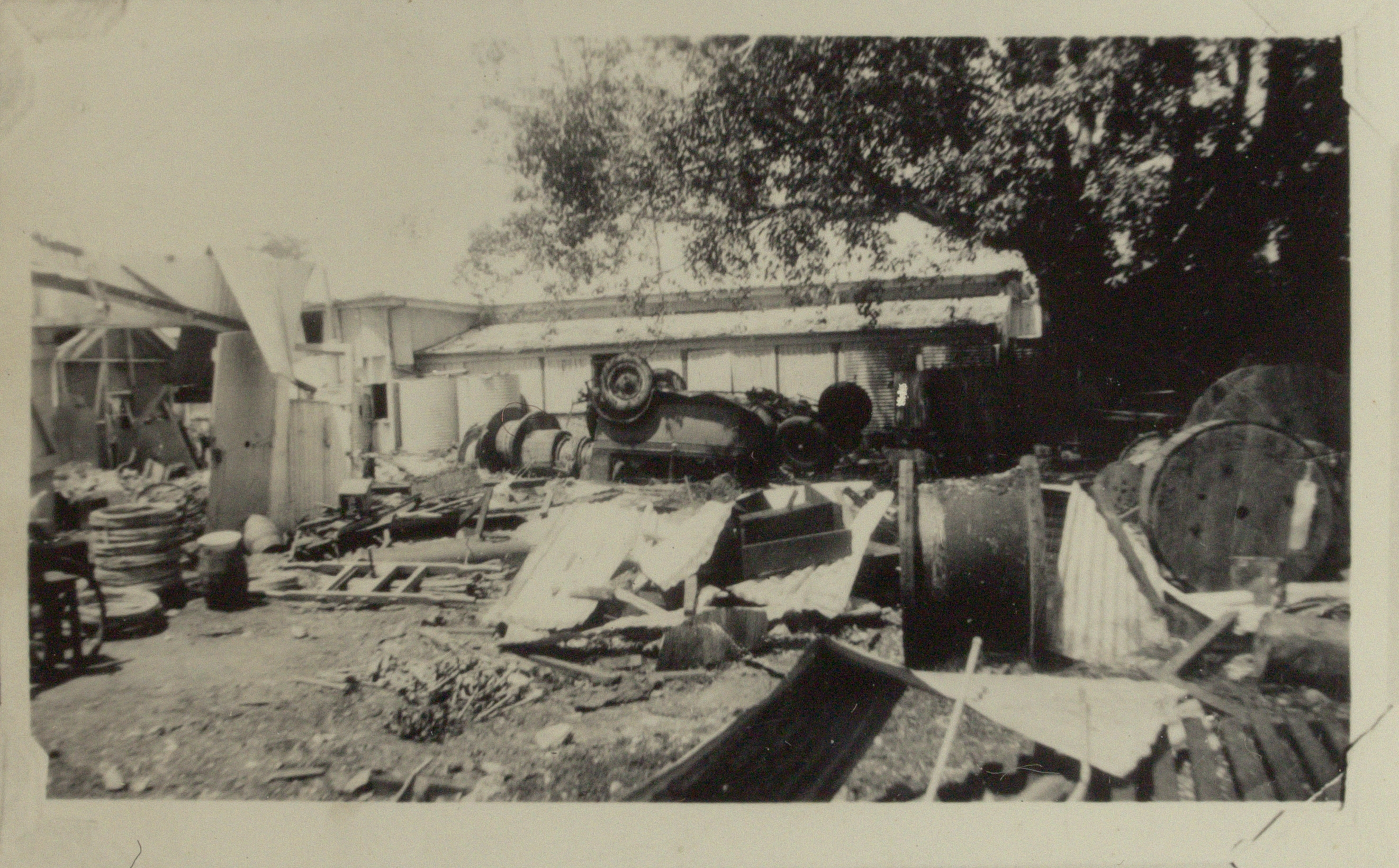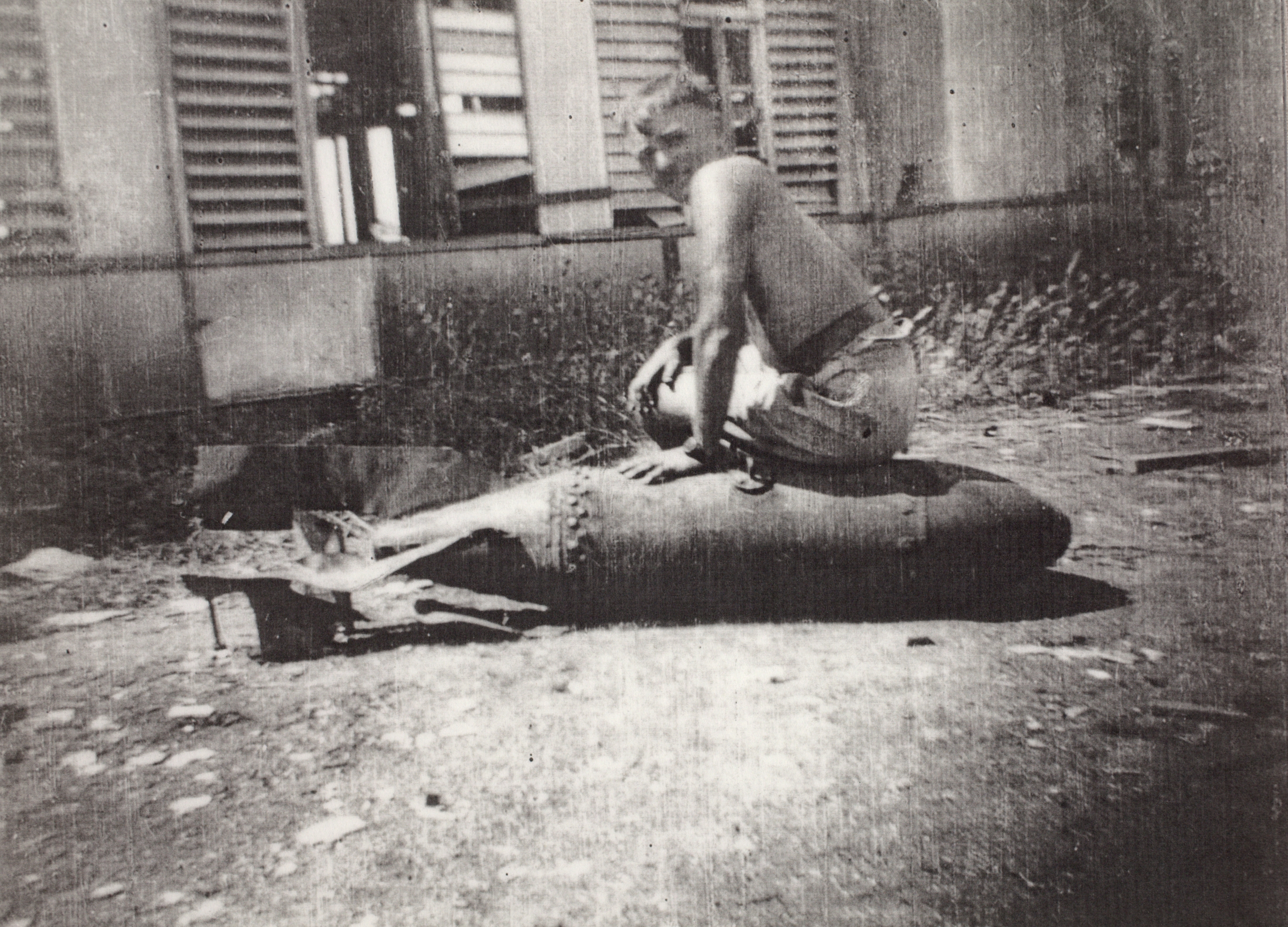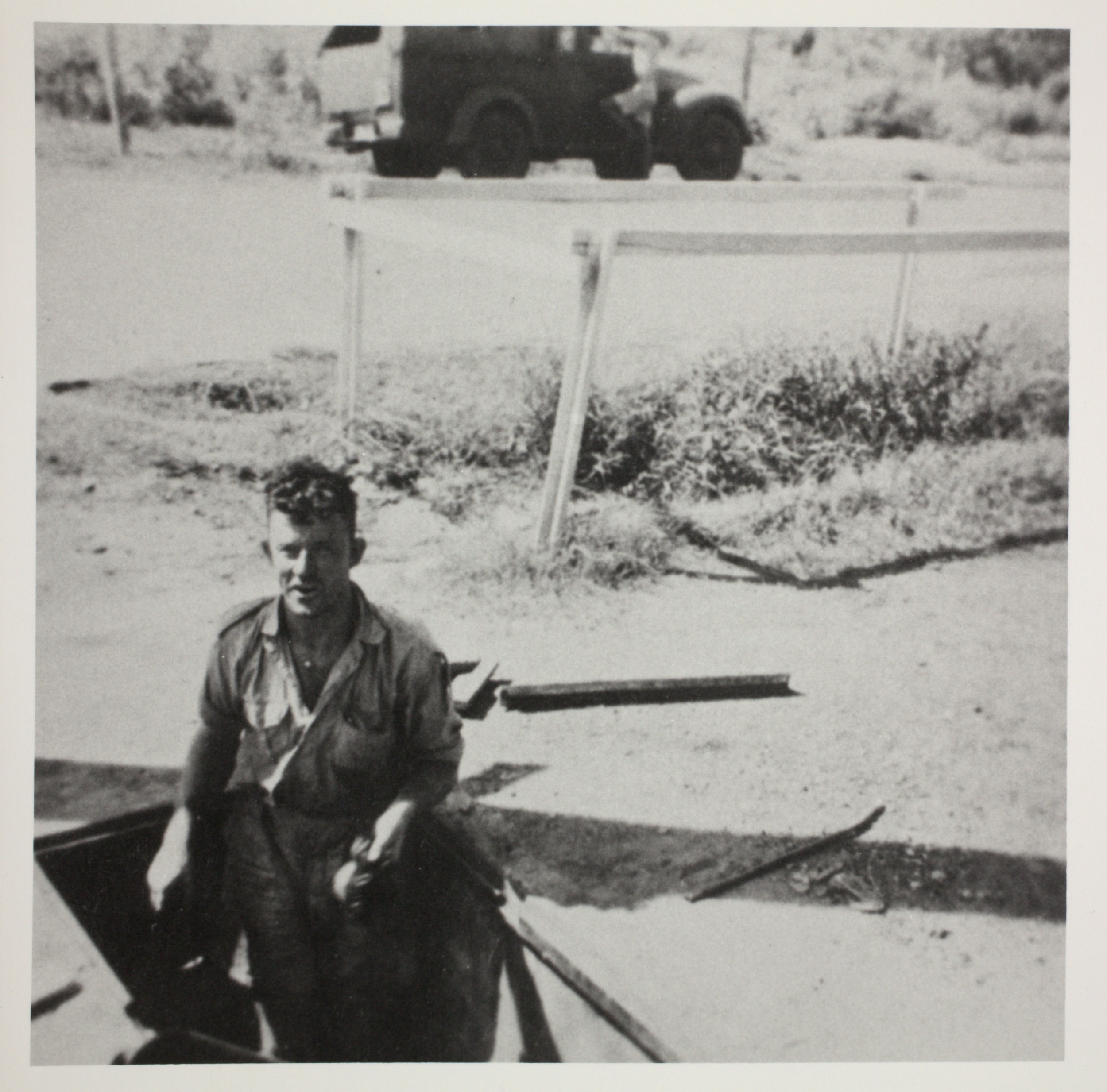Abstract
19 February 2017 marks the 75th anniversary of the first Japanese air raid on Darwin, the capital of Australia?s Northern Territory and its gateway to Asia. The first bombing raid targeted the flotilla of ships in the harbour and key infrastructure such as telecommunications, severing the vulnerable north of Australia from the rest of the country. But the severance was short-lived, thanks to the efforts of dedicated staff of the Postmaster-General?s Department who worked tirelessly under arduous conditions to maintain essential communications between the warfront in the north and the rest of the nation to the south.
Introduction
The ability to communicate over distance is important at the best of times; in times of war it is critical. This was no less the case when the Second World War came to Australian shores on the morning of 19 February, 1942. Just over two months after the Japanese attack on Pearl Harbor, and only days after the Fall of Singapore, Japan launched the first of almost one hundred air raids on the Australian mainland. At least 243 people lost their lives and another 500 were injured when at 9.58 a.m. 188 Japanese fighters, bombers and dive bombers launched the first of its air raids on the Australian mainland. Targeting the town of Darwin in the Northern Territory, the mid-morning bombing raid was the first of 64 launched on the northern outpost and its surroundings; it was also the most devastating.
In the week following the first air raid on Darwin, C. L. A. (Aubrey) Abbott, the Administrator of the Northern Territory, officially wrote to the Secretary of the Department of the Interior informing Canberra of the extent of the damage:
"On the 19th instant, at about 10 a.m., Japanese bombers and dive bombers appeared over the town of Darwin. From reports it would appear that 93 planes took part in the attack. The ?Alert? was given but bombs were bursting before many of the people could take cover . . .
"Bombs fell near the new Darwin Civil Hospital, damaging a ward and houses in the vicinity owned by the Government. The line of bombs then continued along the Esplanade and one fell on the Post Office. The Postmaster, Mr Bald, his wife and daughter, the female telephone staff and two Postal Officers were all killed instantly. The bomb was a direct hit upon a shelter in the Post Office yard where these people were sheltering. Bombs then fell near the Government Offices and upon the Police Barrack, blowing three Constables out of the building without serious injury. Another bomb, at least 500lbs., fell upon the corner of my office, almost entirely demolishing it. I had just left my office. The damage done to the Government Offices is severe, all windows being shattered, and it will not, in my opinion, be possible to use them again without extensive repairs. Government House is damaged, but this was caused at a later time, when the ?Neptuna? blew up at the wharf with a terrific explosion. The attack then continued upon the wharf and shipping in the harbour. A further most intensive raid was made upon the R.A.A.F. station and buildings, including hangers were demolished and transport destroyed.
"The worst effect of the raid was that it entirely interrupted all telephone communications and consequently confusion resulted." (AWM_68_49_687)
The direct hit on the Darwin Post Office and adjoining Telegraph buildings was a devastating blow not only to Darwin and Australia?s lines of communication, it also took a heavy toll on the staff of the Postmaster-General?s Department (PMG), killing ten, injuring more than a dozen and leaving many more again in shock and on edge. Those who lost their lives that day were the Postmaster Hurtle Clifford Bald and his wife Alice Louisa Bald; their twenty year-old daughter Iris Enid Bald; four Telephonists, Emily Florence Young, Jennie Freda Stasinowsky and the sisters Eileen Carrig Mullen and Jean Carrig Mullen; a Postal Clerk named Arthur Wellesley Wellington; a Telegraph Supervisor by the name of Archibald Thomas Roy Halls; and Walter Robert Lewis Rowling, a Foreman Mechanic. (Lowe Commission 1942; Lockwood 1972; National Archives D955, PC 1986/848; Bowden 2016.)
Despite the devastation, the PMG staff who survived the raid continued to go about their jobs under the most difficult and harrowing of conditions. There are many stories of bravery, heroism and courage under fire, such as that of Henry Milton Scott. Henry was a Linesman from Clare in the Mid North of South Australia; he was also the nephew of Hurtle and Alice Bald and a cousin to Iris Bald, all of whom were killed in that first air raid. At the time of the raid, Henry happened to be working at the top of a 26 foot high telegraph pole when he saw the Japanese bombers coming in to launch their attack, including the direct hit on the Post Office where his relatives were taking cover. No less courageous were colleagues like Claude Leonard and Harry Hawke, both engineers, who, along with Telegraph Supervisor W. T. Duke, set about reconnecting Darwin with the rest of the country within hours of the first raid by salvaging what they could from the Post Office bomb site and getting the telegraph system back on the air. (Croft 2012; National Archives D955, PC 1986/848 )
Why Darwin?
Darwin was barely seventy years old when it came under Japanese attack. One of the reasons why it was so crucial to Australian interests, which also made it vulnerable, is that Darwin was the place where the Overland Telegraph line (completed in 1874) met the undersea cable which linked Australia with the rest of the world.
Figure 1. Landing the under-sea Telegraph cable, Port Darwin 7 November 1871 ? Northern Territory Library PH0238-0407 Peter Spillett Collection http://hdl.handle.net/10070/10127
The Overland Telegraph was the means by which Australians connected with the rest of the world, and with each other for that matter, until the 1970s. It was also how the rest of Australia found out about the impending Japanese attack on Darwin, and how we found out about the devastating attack after the fact. As the war came ever closer to Australia, it was decided that, in the event of a Japanese invasion, it would be prudent to cut the international cable linking Australia with the rest of the world. But the line running south remained operational, and on the morning of 19th of February, 1942, Telegraph Supervisor Archibald Halls, one of those killed at the Post Office, was busy testing the telegraph circuit to Adelaide when he broke off, ?Sec.?, or wait a moment, and then tapped out, ?There?s another air raid alarm. I?ll see you shortly?. Quickly adding, ?The Japs have found us and their bombs are falling like hailstones ? I?m getting out of here, see you later?, which was followed by the laugh signal, three dashes and a dot. Of course, he never did.
Within about an hour of the bombing, having salvaged a Morse key and sounder from the badly damaged store attached to the Post Office, PMG officers Leonard, Hawke and Duke improvised a means of hooking into the Overland Telegraph to tap out the news of the attack:
WE HAVE JUST HAD BOMBING RAID WHICH APPEARED
CENTRED ON AND NEAR POSTAL BUILDINGS CAUSING
MUCH DAMAGE AND SEVERAL OFFICERS LIVES LOST
MANY INJURED DON?T KNOW EXACT PERCENTAGE
CURSORY INSPECTION REVEALS POST OFFICE AND
PMS RESIDENCE COMPLETELY WRECKED
TELEG OFFICE AND PHONE EXCHANGE APPEAR INTACT
BUT COVERED MUCH DEBRIS ? AFRAID BALD
FAMILY AND TELEPHONISTS WERE IN THE SHELTER WHICH RECEIVED
DIRECT HIT. (National Archives D955, PC 1986/848 )
This would be the first and most devastating of the 64 bombing raids by the Japanese on the town of Darwin; the next came just two hours later, the last on 12 November, 1943. On the evening of the first two attacks, Prime Minister John Curtin told the nation:
"A severe blow has been struck in this first battle on Australian soil ... We must face with fortitude the first onslaught and remember that whatever the future holds in store for us we are Australians and will fight grimly and victoriously ... Darwin has been bombed, but it has not been conquered".
Concerned that revealing the true extent of the attacks on Darwin would be too great a blow to national morale, Curtin reported that only seventeen people had been killed and another twenty-four injured in the raids of 19 February (National Archives D955, PC 1986/848). Prime Minister Curtin was right in that Darwin was never conquered, nor was that necessarily the Japanese intention, but it was severely damaged and greatly diminished as a supply base from which Allied forces could launch counter-attacks.
Post Office Hit
Thursday 19 February, 1942 was a disastrous day for Darwin and a devastatingly tragic day for the Postmaster-General?s Department. Although, despite some tension in the air and the realisation that the enemy was nearby, the day had started out rather optimistically for at least one member of staff. Just before 10 a.m. that morning, someone in the Darwin Post Office was busy conducting a test on the new Trans-Pacific radio hook-up that made Darwin a key news office in the Columbia Broadcasting System?s (CBS) Far-East network. ?Hello Frisco: This is Darwin?, said the voice over the airwaves, all the way to CBS stations in San Francisco and New York, ?everything is fine here. It is a bright sunny day, with nothing moving. I will call you at the same time tomorrow?. Tragically, that did not happen. What started out as a bright and sunny, albeit nervous kind of day soon became one of the darkest days in Australian war-time history: nine Post Office workers were killed instantly, another suffered mortal wounds, many more were injured and many more again were severely shaken by the day?s events. (National Archives D955, PC 1986/848 )
In the days after the first Japanese air raids, Police Constable Leo Charles Francis Law, who was stationed in Darwin at the time, prepared the following report, which was later submitted to the Lowe Commission (Lowe Commission 1942; Australian War Memorial 54, 625/3/1 ):
"I state that on 19/2/?42 the following bombs were dropped and the following damage and deaths were caused in Darwin due to enemy action ?
Two 500 Kilogram H.E. [High-explosive] bombs or 1,050 lb bombs on Esplanade outside Post Office Quarters.
One 500 Kilogram H.E. bomb or 1,050 lb bomb fell just off Esplanade outside Cable Quarters.
Two 500 Kilogram H.E. bombs or 1,050 lb bombs fell opposite the Postmaster?s residence, one of these being near the cliffs.
One 500 Kilogram H.E. bomb or 1,050 lb bomb fell on the Postmaster?s residence. This was a direct hit, killing the following nine people: Mr, Mrs, and Miss Bald; Mrs Young; the two Mullens [Mullen] sisters; Mr Walls [Halls]; Miss Stasinowsky; Mr Wellington; The Postmaster?s residence is a total loss.
One 500 Kilogram H.E. bomb or 1,050 lb bomb fell in the yard of the Linesmen?s Workshop House on corner of Mitchell and Bennett Sts ?
Damage:
Postmaster?s residence, three Post Office Houses in Esplanade, the Overland Telegraph Quarters, and the Cable Office were all rendered unsafe as dwellings, and were all complete loss."
Lieutenant H. N. Deveson of the Bomb Disposal Squad later reported that ?nineteen 500 kg bombs were dropped in an area of 200 yards square? in the Darwin Post Office precinct.
Figure 2. Post Office and Postmaster's residence before the first air raid ? (National Archives: D955, PC1986/848)
Back on the Air
Despite the devastation, the chaos, the injuries and the loss of life inflicted on PMG staff by the Japanese bombing of the Darwin Post Office and adjoining Telegraph buildings and infrastructure, the dust did not have time to settle before staff quickly got on with what they knew had to be done. As noted already, within an hour of the first air raid, news of the attack was promptly passed on to relevant authorities in the south of the country. In a report to the Superintending Engineer, which was written just over a week after the air raids, the Acting Divisional Engineer in North Australia, Harry Hawke, wrote that the ?installation of emergency equipment was at the time of the raid proceeding at the Lands Department Office in Cavanagh Street?. As he emerged from taking cover following the first raid, Claude Leonard, the Acting Senior Mechanic, looked about and came to the realisation ?that telegraphically we were cut off from Adelaide?. Given the extent of the damage to the buildings and equipment at the Post Office and adjoining Telegraph buildings, he ?decided to make all haste to the Lands Department Office and set up temporary telegraph communication with Adelaide?. (National Archives D955, PC 1986/848 )
Figure 3. Post Office and Postmaster?s residence after the first air raid on 19 February 1942 ? a Northern Territory Library PH0250-0026/0059 Watts Collection http://hdl.handle.net/10070/14071
In order to do so, Leonard made his way to the Mechanics? Engineers? store where he procured a Morse key and sounder with batteries and a Morse relay. He and a number of colleagues then made their way to the Lands Department Office in the mechanics? van where they found some of the engineering staff, including Hawke, who were already in the process of installing power plant in preparation to establish an emergency Telegraph Office. As Leonard explained in his account of that horrible day, ?the main telegraph lines to Adelaide had already been teed [or joined] into this building?, so they quickly set up the Morse equipment and ?connected it to the copper line No. 40.? According to an account of one of the PMG staff present in the Lands Department Office:
"Alice Springs was contacted and the Postmaster was in attendance at the repeaters. He quickly made the necessary adjustments on the duplex repeaters to suit our Morse terminal and put us through to Adelaide Chief Telegraph Office, when I requested that the Deputy Director, Mr. Arnold, be asked to come on the line. Within a few minutes Mr. Arnold was in attendance and with Mr. Duke operating the key I was able to give a quick account of the happenings to the Darwin Post Office and its staff during the past hour. The raid commenced within a few minutes of 10 a.m. and although I do not remember how time had flown, I was afterwards informed that it was somewhere about 40 to [illegible] minutes afterwards that we were in contact with Adelaide from our emergency station." (National Archives D955, PC 1986/848)
Figure 4. Bomb damaged Post Office buildings and yard ? Northern Territory Library PH0238-0333 Peter Spillett Collection http://hdl.handle.net/10070/13278
Another account of how the news of Japan?s first attack on the Australian mainland was broken to the rest of the nation, or at least some of them, has a slightly different twist on it. On the morning of the attack, J. L. Skerrett, a PMG Engineer form the Central Office Transmission Section was working in Alice Springs at the repeater station as part of the concerted effort to complete the telephone circuit linking Adelaide and Darwin. Having lost all contact with Darwin, but not knowing the extent of the problem or precisely why, Skerrett and Norman Lee, the station?s Telegraph Supervisor, hooked up some diagnostic equipment and, to their surprise, detected a Morse signal coming along the line ? the message being tapped out by Duke.
It is reported that Skerrett promptly phoned PMG headquarters in Melbourne, thanks to a line connection that had just been completed the previous day, and relayed the message he had just received to L. B. Fanning, the Acting Director-General of the PMG. Fanning in turn called the Prime Minister, John Curtin, to break the news of the air raid and its consequences; he then told Skerrett to destroy the original message and keep the news to himself. It is quite possible that both of these versions of how the news broke were going on at the same time: as the breaking news was being passed on by Hawke and others to the Deputy Director in Adelaide; it was also being relayed by Skerrett to the Director-General in Melbourne. Many have argued that the news of what was happening in Darwin and the extent of the damage done and the loss of life were heavily censored by the Australian government in order to preserve the nation?s morale (Moyal 1984; National Archives D955, PC 1986/848).
'Knuckey?s Lagoon' Exchange
Having made initial contact with the authorities to the south, it was soon realised that something more sustainable would be required to deal with the growing communication demands in and out of Darwin and its surrounds. The Lands Department Office was housed in a two-storey timber building that wasn?t likely to withstand much of a blast should a bomb be dropped in its vicinity; it was nowhere near as sturdy as the Post Office and that had been rendered entirely uninhabitable. The need for a more reliable communications headquarters was further driven home by the fact that the second air raid targeting the RAAF Aerodrome just outside of Darwin had also inflicted severe damage on the telegraph wires running to the base, which again interrupted the connection with Adelaide.
Having advised the Army?s Officer Commanding Signals of the second disruption to telegraph communications, it was agreed among senior PMG personnel that a telephone exchange should be re-established further out of harm?s way at a second emergency location. The chosen site was a relatively small hut 10 miles south of Darwin on the railway line, which became known as 10-mile camp. All PMG officers that were not required for emergency repairs in Darwin were instructed to relocate to the camp where the Army would arrange for the provision of tents and rations. Claude Leonard reported that not long after arriving at the ?small hut on the railway line known as ?the 10 mile? or ?Knuckey?s Lagoon? we soon had the Morse set connected to the telegraph line and re-established communication with Adelaide?. By this time it was about 3 o?clock in the afternoon and they were ?somewhat disappointed at the fact that nearly four hours had elapsed since we had last been in telegraph contact with the rest of Australia, particularly at such a vital time when so much depended upon maintaining continuous service?. There was little time to reflect, however, for there was soon a regular procession of Army Signals despatch riders arriving at the camp on motor cycles with a steady flow of telegraph traffic for the increasingly busy and increasingly crucial 10-mile telephone exchange.
By late in the afternoon on 19 February, the 10-mile campsite was a relative safe-haven in the bush for as many as fifty to sixty PMG staff. When not working, most were camped in tents that were scattered through the scrub about forty yards apart and no closer than 200 yards or so from the hut that served as the Telegraph Office and, initially at least, the cookhouse. The camp was well served by two cooks who made the best of the bad situation, salvaging what cooking implements they could from their respective Messes at the Post Office and the Telegraph Exchange. Fortunately, one of the things salvaged included a large pot of stew that was being prepared by one of the cooks for the evening meal. After nursing it carefully throughout the 10 mile journey south from Darwin, the cook put the finishing touches to what was a most welcome hot meal.
A batch of scones being prepared for morning tea at 10.30 a.m. in the other Mess was not so fortunate, having fallen victim to a bomb blast that demolished the kitchen. Once a degree of composure had been restored to postal and telecommunications services, from 5 March many PMG staff were relocated further south again to a second camp 22 miles from Darwin where the Department of the Army was erecting a communications hut that could accommodate Telegraph and Signals Headquarters staff.
Back in Darwin town, work was going on day and night to repair the damage done to cables and wires during the air raids. It was thought that further raids were most likely to occur between 10 a.m. and 3 p.m., so whenever possible PMG staff kept away from potential target areas during those times. They commenced their repair work as soon as the sun came up at around 6 a.m. and worked through until about 10 a.m; they then headed back to camp before returning to their tasks at about 3.30 in the afternoon and working until sunset at around 7 p.m. If artificial light was available and it was safe to do so, they continued working into the night. Underground cables lying damaged and exposed in bomb craters near the RAAF Base and the Police Officers? Mess and Quarters were repaired the day after the raid; but fixing the many aerial wires and the poles that supported them, including the stretch of line running along Mitchell Street from around the Hotel Darwin to the shattered Post Office was a much bigger job. The presence of unexploded bombs didn?t help matters either, so it is was another week before the repairs were completed on the 27th of February. (National Archives D955, PC 1986/848 )
Figure 5. George A. Marven astride a defused unexploded 250 pound Japanese bomb ? Northern Territory Library PH0491-0001 E. J. Braid Collection http://hdl.handle.net/10070/37402
The air raids on Darwin that caused so much damage to the telecommunications infrastructure came two days before the final touches were due on the telephone lines and equipment that would have completed the speaking circuit between Adelaide and Darwin. Needless to say, this was a most unwelcome setback for the venture that had started so many years earlier with the planning and laying of the Overland Telegraph. In the wake of the air raids, a Superintendent Engineer from Adelaide named Tom Henry was sent to Darwin to oversee the completion of the circuit. Lineman Henry Scott was one of those responsible for laying the coated wire along Mitchell Street to what he described as ?the bombed out exchange where a portable telephone was connected to where the old switchboard stood?. As he later recalled, ?this happened about a fortnight after the first bombing raid on Darwin, around the first week of March, 1942. As I was the linesman, it was my duty to test the line. It was as clear as a bell when I spoke to the chief in Adelaide. Mr Henry then took over and spoke to the Deputy Director in Adelaide making the historic occasion official?. Despite the trauma he had been through in Darwin, he later reflected on ?what a privilege it was that my voice was the very first to be speaking down the line to the chief in Adelaide that day?. (Croft 2012)
Figure 6. Herb Page in a Manhole at the corner of Daly and Mitchell Streets ? Northern Territory Library PH0480-0013 Jean Page Collection http://hdl.handle.net/10070/3947
Within a matter of months the relocated Darwin Telegraph Office was operating around the clock and sending in excess of 10,000 words a day in messages, telegrams and cables, with almost as much traffic incoming. The vast majority of these messages were generated by the military and related to the defence of the nation; as Harry Hawke reported, ?since the raid many requests have been made by both Department of Army and RAAF for additional services to dispersal points at which they have established themselves?, which the PMG endeavoured to meet ?wherever practicable?.
William Hales, a survivor of the first air raids on Darwin, who came from Coffs Harbour in New South Wales, ably took on the role of Acting Supervisor of the five telegraphists handling all of the traffic, a job that kept him busy from 8.30 in the morning until 11.30 at night. His four colleagues similarly worked about ten to twelve hours a day, seven days a week to maintain the flow of traffic. Not all of this traffic, however, was official Defence business; quite a bit of it included personal messages from soldiers to friends and families. Among these personal messages were the wedding vows of two American soldiers, Lieutenant William Spitz-Miller and Private Benjamin Vaughan, who made use of the telegraph cable service to wed their loved ones back home in the United States. (Pratt 1942)
Conclusions
The PMG staff who survived the air raid on Darwin on the morning of the 19 February, 1942 performed a remarkable job in repairing and maintaining essential communications between the warfront in the north and the rest of the nation to the south, under arduous and dangerous conditions
It seems inappropriate to single out one or two people in particular, because all were reported as doing their job admirably in the face of adversity. As the Acting Divisional Engineer, Harry Hawke, later reported, ?those of the staff who were not injured or were slightly injured have for the most part carried out their duties courageously?. For whatever reason, as a society we are inclined to identify certain people, ?heroes? if you like, who are afforded a special mention ? and Harry Hawke was no different. He noted that ?several particular instances of devotion to duty are worthy of mention. Acting Senior Mechanic Leonard has performed particularly meritorious work from the very moment the raid ceased. He immediately commenced wherever possible restoring services, diverting services, and has worked day and night irrespective of danger in order that defence lines shall remain intact?. A Lineman by the name of Herb Page was also identified as having ?played a conspicuous part in carrying out much cable repair work, alterations, etc. and has assisted Leonard in no small degree?.
Hawke felt that ?one other officer should be mentioned for the work he did under severe conditions. This is J. C. [Jim] Willsmore [or Wilsmore], Postal Clerk, who was sheltering in the Postmaster?s shelter when the telephonists entered. He immediately left the shelter and returned to the exchange where he continued operating throughout the raid. Later in the day when most members of the Postal Staff had left the precincts of the town, Willsmore remained behind with Messrs. Leonard and Page assisting them where possible in diverting urgent services to the Larrakeyah P.B.X.?
Naturally, Harry Hawke neglected to mention his own crucial role in restoring communications in the immediate aftermath of the first air raid and the leadership he ably demonstrated in coordinating and assigning jobs to his PMG colleagues. For some reason it was his colleague W. T. Duke, the man tapping out the Morse code message that notified the rest of the nation of the Japanese attack on Darwin, whose contribution was formally acknowledged with the awarding of a B.E.M., the British Empire Medal for Meritorious Service. Tom Mansfield was similarly singled out among the Postal staff and was awarded a B.E.M. for assuming responsibility for postal services under particularly dangerous conditions following the death of Postmaster Hurtle Bald. While the other seventy-odd officers of the Postmaster-General?s Department who were based in and around Darwin when it came under Japanese attack might not have received medals from the Crown in recognition of their invaluable service in maintaining essential communications when the Australian nation was at war and under threat, their roles are no less worthy of merit and our appreciation.
References
AWM 68 49/687 Letter from C. L. Abbott, Administrator of the Northern Territory to The Secretary of the Department of the Interior, 27 February, 1942. Australian War Memorial
AWM 54, 625/3/1 PART 1, Darwin - Air Activity (Enemy):] Enemy Air Activity - Darwin Area, February - March 1942. Australian War Memorial
AWM54, 812/3/16 [Raids (Air) ? Enemy (including damage):] Report on Bombing in Darwin (including Medical Report by Dr Kirkland) Australian War Memorial
Bowden, Brett. 2016. Direct Hit: The Bombing of Darwin Post Office. Sydney: Rosenberg.
Burstow, TJ. 1942. Tom James Burstow, Rough diary air raids on Port Darwin and intermediate alerts. Northern Territory Archives Service. Available at: http://artsandmuseums.nt.gov.au/northe n-territory-library/the-territorys-story/territorians-at-war/thomas-burstow
Clune, Frank. 1955. Overland Telegraph. Sydney: Angus and Robertson.
Commission Of Inquiry Concerning The Circumstances Connected With The Attack Made By Japanese Aircraft At Darwin On 19th February, 1942 (Lowe Commission). National Archives of Australia A816, 37/301/310
Croft, Simmone. 2012. Red Spots Over Darwin. Darwin: Simmone Croft.
Lockwood, Douglas. 1972. Australia?s Pearl Harbour: Darwin 1942. Adelaide: Rigby.
Moyal, Ann. 1984. Clear Across the Country: A history of telecommunications. Melbourne: Nelson.
NAA: D955, PC 1986/848 Air raid on Darwin Post Office 19 February 1942. National Archives of Australia
Pratt, Mel. 1942. ?Overland Telegraph: Romance of To-day and Yesterday?, Sydney Morning Herald, 03 October 1942, p. 7.

